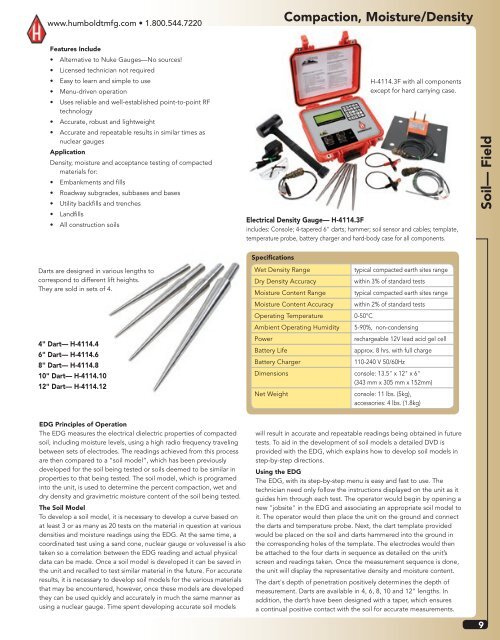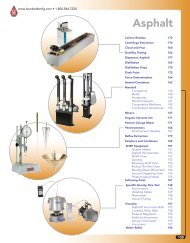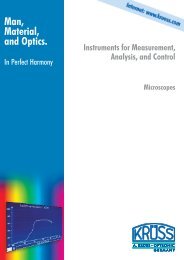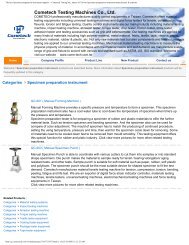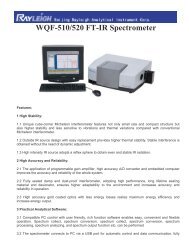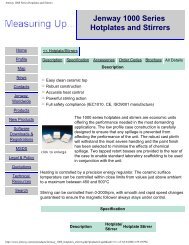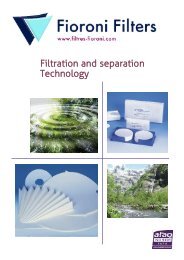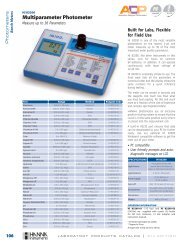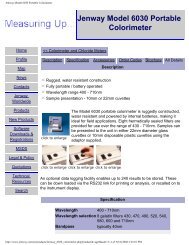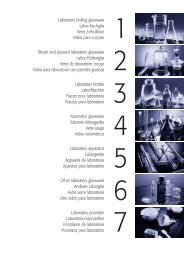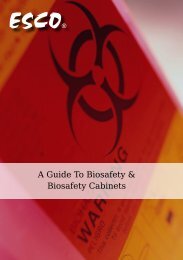Humboldt Catalog - Soil-Field Section - Comlibris
Humboldt Catalog - Soil-Field Section - Comlibris
Humboldt Catalog - Soil-Field Section - Comlibris
Create successful ePaper yourself
Turn your PDF publications into a flip-book with our unique Google optimized e-Paper software.
www.humboldtmfg.com • 1.800.544.7220<br />
Features Include<br />
• Alternative to Nuke Gauges—No sources!<br />
• Licensed technician not required<br />
• Easy to learn and simple to use<br />
• Menu-driven operation<br />
• Uses reliable and well-established point-to-point RF<br />
technology<br />
• Accurate, robust and lightweight<br />
• Accurate and repeatable results in similar times as<br />
nuclear gauges<br />
Application<br />
Density, moisture and acceptance testing of compacted<br />
materials for:<br />
• Embankments and fills<br />
• Roadway subgrades, subbases and bases<br />
• Utility backfills and trenches<br />
• Landfills<br />
• All construction soils<br />
Darts are designed in various lengths to<br />
correspond to different lift heights.<br />
They are sold in sets of 4.<br />
4" Dart— H-4114.4<br />
6" Dart— H-4114.6<br />
8" Dart— H-4114.8<br />
10" Dart— H-4114.10<br />
12" Dart— H-4114.12<br />
EDG Principles of Operation<br />
The EDG measures the electrical dielectric properties of compacted<br />
soil, including moisture levels, using a high radio frequency traveling<br />
between sets of electrodes. The readings achieved from this process<br />
are then compared to a “soil model”, which has been previously<br />
developed for the soil being tested or soils deemed to be similar in<br />
properties to that being tested. The soil model, which is programed<br />
into the unit, is used to determine the percent compaction, wet and<br />
dry density and gravimetric moisture content of the soil being tested.<br />
The <strong>Soil</strong> Model<br />
To develop a soil model, it is necessary to develop a curve based on<br />
at least 3 or as many as 20 tests on the material in question at various<br />
densities and moisture readings using the EDG. At the same time, a<br />
coordinated test using a sand cone, nuclear gauge or voluvessel is also<br />
taken so a correlation between the EDG reading and actual physical<br />
data can be made. Once a soil model is developed it can be saved in<br />
the unit and recalled to test similar material in the future. For accurate<br />
results, it is necessary to develop soil models for the various materials<br />
that may be encountered, however, once these models are developed<br />
they can be used quickly and accurately in much the same manner as<br />
using a nuclear gauge. Time spent developing accurate soil models<br />
Specifications<br />
Compaction, Moisture/Density<br />
H-4114.3F with all components<br />
except for hard carrying case.<br />
Electrical Density Gauge— H-4114.3F<br />
includes: Console; 4-tapered 6" darts; hammer; soil sensor and cables; template,<br />
temperature probe, battery charger and hard-body case for all components.<br />
Wet Density Range typical compacted earth sites range<br />
Dry Density Accuracy within 3% of standard tests<br />
Moisture Content Range typical compacted earth sites range<br />
Moisture Content Accuracy within 2% of standard tests<br />
Operating Temperature 0-50°C<br />
Ambient Operating Humidity 5-90%, non-condensing<br />
Power rechargeable 12V lead acid gel cell<br />
Battery Life approx. 8 hrs. with full charge<br />
Battery Charger 110-240 V 50/60Hz<br />
Dimensions console: 13.5" x 12" x 6"<br />
(343 mm x 305 mm x 152mm)<br />
Net Weight console: 11 lbs. (5kg),<br />
accessories: 4 lbs. (1.8kg)<br />
will result in accurate and repeatable readings being obtained in future<br />
tests. To aid in the development of soil models a detailed DVD is<br />
provided with the EDG, which explains how to develop soil models in<br />
step-by-step directions.<br />
Using the EDG<br />
The EDG, with its step-by-step menu is easy and fast to use. The<br />
technician need only follow the instructions displayed on the unit as it<br />
guides him through each test. The operator would begin by opening a<br />
new "jobsite" in the EDG and associating an appropriate soil model to<br />
it. The operator would then place the unit on the ground and connect<br />
the darts and temperature probe. Next, the dart template provided<br />
would be placed on the soil and darts hammered into the ground in<br />
the corresponding holes of the template. The electrodes would then<br />
be attached to the four darts in sequence as detailed on the unit’s<br />
screen and readings taken. Once the measurement sequence is done,<br />
the unit will display the representative density and moisture content.<br />
The dart's depth of penetration positively determines the depth of<br />
measurement. Darts are available in 4, 6, 8, 10 and 12” lengths. In<br />
addition, the dart’s have been designed with a taper, which ensures<br />
a continual positive contact with the soil for accurate measurements.<br />
<strong>Soil</strong>— <strong>Field</strong><br />
9


